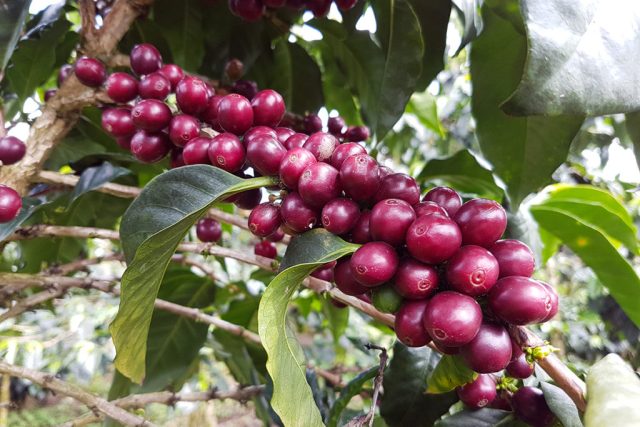I’ve been holding my breath and crossing all my fingers for the arrival of the Serra do Bone for this edition of Red Brick, and now that it’s finally safe in-house I’m taking a deep sigh of relief and steadying my nerves with a shot of espresso or two.
The work of a green buyer often seems a bit mysterious and exotic, but I can promise you there is a lot of plain, dry logistics and bureaucracy to deal with. The work towards getting a new coffee in-house tends to start four to six months ahead of time with visits to the farms and numerous sample cupping sessions. But, in spite of careful prep and best-laid plans, coffee has a way of throwing challenges at you that you just have to roll with.

This year, as I went to book our containers out of Brazil, I was faced with a projected three-month timeline before we could get a spot on a ship, rather than the typical three- to four-week wait. An issue I’d never encountered before had resulted in a severe backlog of shipments out of the port of Santos, from where we move all our Brazilian coffee.
For whatever reason, the port had not been dredged for far too long, and the sediment on the bottom had built up so high that the safety requirements for full capacity cargo shipping could not be met. In order to sit high enough in the water for the ships to clear the port without getting stuck, ships were leaving Brazil at 70-80% capacity, and everyone trying to move all sorts of goods were queuing up for extended waits.

Arriving ships were also only allowed a reduced load in order to dock, meaning containers had to be removed at other ports or by other means before landing in Santos. In addition, a recent slow down of the Brazilian economy means there were fewer containers arriving overall, and thus fewer empties around for us to fill with lovely coffee. Combined with bad weather, the situation looked grim for a pre-Christmas arrival of the Serra do Bone.
However, due to the collective efforts of our exporters, the logistics magicians at Hapag-Lloyd and many of our wonderful friends in coffee, I managed to get a spot on a November sailing, allowing my shoulders to finally lower a bit! As is often the way, though, I celebrated too soon. A couple of days before planned departure, an email came through – the stowage plan for the MSC Elodie had to change last minute, and we were being bumped to CNI Andes which was due to sail the following week.
My shoulders crept back up towards my ears.

The ETA for this ship was Dec 22nd, leaving a very, very small window, over the holidays, for the port, the customs clearing agents, the warehouse and the trucking company all to play their part and to get the coffee to the roastery. And for my poor roasters, it leaves a very tight window to get the coffee test roasted and dialled in for production.
But here we are and because my roasters are incredible, and somehow magic happens when good people pull together, a new Red Brick is ready to see us through for the next three months or so before more fresh coffee arrives. We have paired the sweet caramel chocolate notes of the Serra do Bone with the fresh lively fruit tones of one of our longstanding favourites, the Serrania from Colombia. We hope you enjoy it, it’s as fresh off the boat as it gets!

SERRA DO BONE, BRAZIL
Region: Araponga
Producer: Carlos Sergio Sanglard
Harvest: Sep-Dec
Varieties: Bourbon, Catuai
Process: Pulped Natural
Altitude: 1,200m
Landed: Dec
A pioneer within speciality coffee in the Araponga region of Minas Gerais, Carlos Sergio has invested not only in quality but also in the sustainability of coffee production. His skill and focus have seen him place in the top 5 of the Cup Of Excellence three times, taking the 1st place as early as 2003.The farm’s altitude of 1200 masl is high for Brazil, which adds to the brightness and texture of his coffee. He takes an organic approach to farming, conserving resources and managing his crop with minimal artificial intervention.

Since buying the farm in 1988 he expanded the then 7 hectares of coffee to 87 hectares and keeps another 73 hectares preserved as native forest. Carlos Sergio separates and tracks his lots based on standards for organic production, and takes special care at every step in the process, from the washing and pulping to drying the coffee on suspended concrete patios. Says Carlos of his philosophy of farming: “When I take care of nature, nature will take care of my coffee and my people.”
SERRANIA, COLOMBIA
Region: Palestina
Producer: various smallholders
Harvest: July-Oct
Varieties: Caturra, Colombia
Process: washed
Altitude: 1700”“1800m
Landed: November

Firmly becoming a wintertime staple in Red Brick, the Serrania has returned and is tasting as sweet and balanced as ever, exactly what we enjoy in our espresso. This coffee comes from a group of small growers in the municipality of Palestina, which is just south of the town Pitalito in the Huila region. We were able to visit a few of the contributors last year, walking the farms and looking at their milling facilities. Serrania has been on our offer list for many years now and we have contracted their coffee for the future as well, ensuring a long-term relationship that both sides benefit from.

This year we find the coffee to be the juiciest it’s ever been, a fun development that adds nicely to the complexity of this Red Brick. We couldn’t be happier to have the Serrania feature in our offering once again.
BUY SOME HERE

Red Brick
£10.50tasting notes






